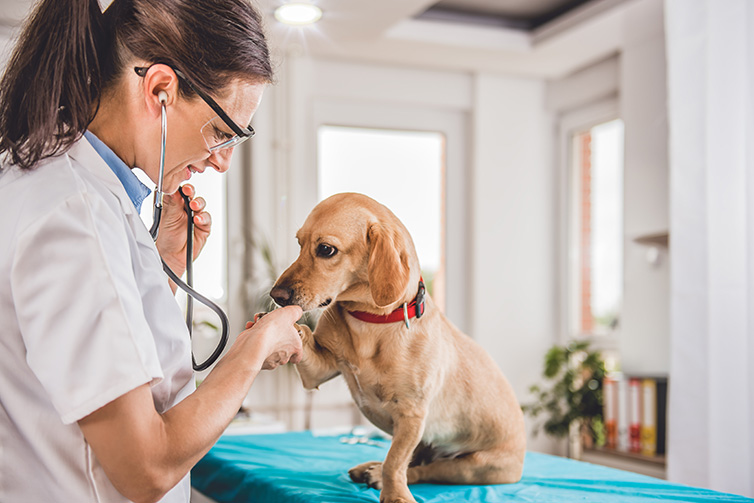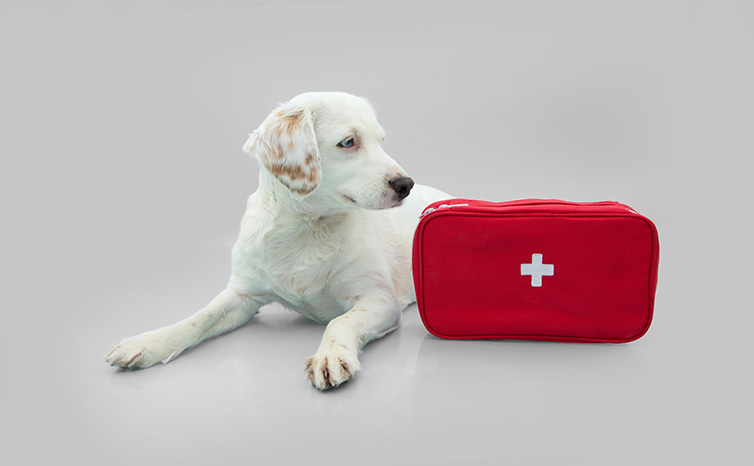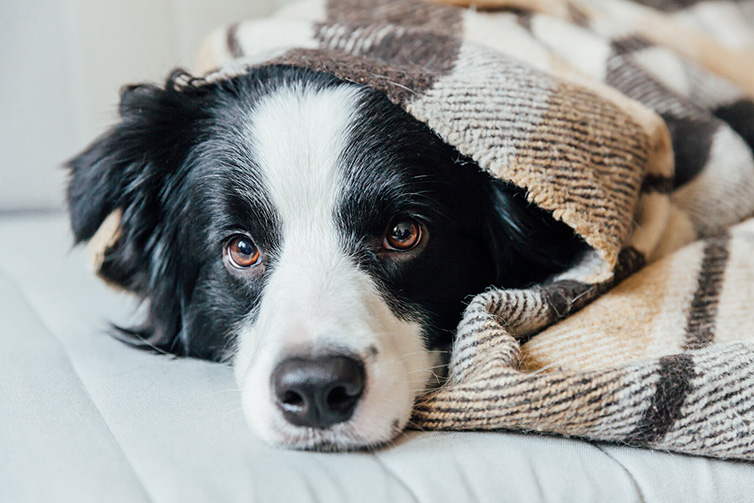Help! Emergency!

Imagine this scenario:
You arrive home, greeted by your dogs, of course, and as you walk into your bedroom you discover, to your horror, that a packet of your high blood pressure pills lies torn and chewed on the floor. What do you do? Panic, naturally. You frantically try to check how many are missing but you can’t work it out. You grab each dog in turn, desperately scrutinising their mouths and shoving your fingers down their throats, in an attempt to extract the chewed pills. Both dogs seem O.K., but … You go online but you can hardly read the information as, by now, you have worked yourself up into full panic-stations. Meanwhile, your dogs are watching you as if you are a lunatic.
Similar situations have happened to most of us. Accidents can and do happen, however careful we are. Animals act on instinct, not common sense, which may make them vulnerable to accidents and emergencies.
An accident can happen to your own pet in your home or garden. But you may come across an injured animal or even accidentally hit one with your car. In this article we are assuming that the injured animal may be your own or may belong to a stranger. In either case, a beloved pet needs help…fast.
REMEMBER: You may be the only person available to help, so you need to get clued-up in order to possibly save an animal’s life.
First Rule of Thumb?
CALL YOUR VET.
WE REPEAT: CALL YOUR VET!

If possible, get someone else to phone her/him, while you deal with your pet.
There is absolutely no substitute for your vet’s opinion, advice and treatment.
He/she will probably advise you to come in – an emergency situation will always be treated immediately. But, in many cases, there are things you can do to minimise the shock and suffering of your beloved pet. It is very important that every pet owner or carer, knows the basic first aid steps to take before you and your pet manage to get to the vet.
FIRST AID KIT

Don’t wait for an emergency to happen. Get a first aid kit now. The contents are fairly basic:
- Bandages, of various sizes
- Antiseptic wound wash
- Antiseptic wipes
- Cotton wool or cotton pads
- Tweezers
- Self-adhesive tape and/or plasters
- Blunt-ended scissors
- Dressings, of various sizes
- Surgical and vinyl gloves
- A foil blanket
- Keep a blanket available to use as a stretcher
IN THE CASE OF SERIOUS INJURY

WHAT SHOULD I DO FIRST AFTER PHONING MY VET?
Come on. You can do this. You can save an animal’s life.
- Keep calm and keep your pet calm. Depending on the situation, assess the surroundings for any further potential danger to you or your pet.
- Keep your pet quiet and warm. If there are signs of serious trauma e.g. broken bones, head injuries, try to move your pet as little as possible. Talk to and gently stroke him/her to reduce anxiety.
- If your vet advises you to take your pet in, try to get someone to help you. A small dog or cat may travel in a pet carrier or a box, but be careful not to push him/her in. For a larger dog you may need to make a stretcher, preferably out of a large, flat piece of wood. You can also use a blanket, which you carefully slide under your dog, then two of you, holding the corners, lift him/her into the car. If possible, put the back seats down to create a large, flat space.
- Drive carefully and slowly.
HOW DO I RESTRAIN AN INJURED DOG?
Pain and stress can cause a calm and placid pet to become aggressive, so act with caution when you are dealing with an injured animal. The safety of everyone involved with assisting you and an injured animal is very important. If the animal is biting and acting aggressively, there are some restraints that you can use:
- You can wrap the animal in a blanket, ensuring that the head is out and that injured limbs are moved as little as possible.
- If the shocked and scared animal is biting, make a muzzle out of a strap, leash, rope or piece of fabric. Wrap it around the dog’s muzzle, make it fairly tight (as long as the muzzle is not injured) and tie it. Animals do not need their mouths to be open to breathe; they can breathe through their nostrils as long as these are not obstructed.
- If you think that the animal may have a spinal injury, movement may cause permanent paralysis. If your vet gives you the ‘go-ahead’, carefully slide a board under the animal, trying to ensure that the head and neck are immobilised.
WHAT ARE THE SIGNS OF SHOCK AND WHAT SHOULD I DO?
In cases of severe injury or serious loss of blood, circulation decreases, blood pressure falls and if the shock is not treated quickly, body cells can be damaged, which can be fatal. The injured animal may start breathing rapidly with an elevated heart rate and pale gums, lips or under the eyelids. He/she may vomit, shake and then may become unresponsive and quiet.
HOW CAN I HELP AN ANIMAL SHOWING SIGNS OF SHOCK?

Again, keep the animal quiet and calm and cover him/her with blankets, towels or anything you have to hand, including newspapers, to conserve body heat.
Apply the first aid A, B, C:
Airway
Try to clear the mouth and throat of any obstructions, including vomit. (Be strong and keep calm.) Be careful that you don’t get bitten. Preferably use a tool, such as a spoon or tweezers.
Breathing
If there are no signs of breathing and the animal is unconscious, gently pump the chest with the palm of one hand, checking for a pulse or heartbeat. If this does not start the animal breathing, then try ‘rescue breathing’ as follows:
- Gently pull the tongue out of the mouth and extend the head and neck so they are in a straight line. DO NOT attempt to do this if you suspect head or neck trauma.
- Clear the mouth of any obstructions. Often, obstructions can be removed by holding the animal upside down (provided he/she is small enough) with its back against your chest and give several sharp thrusts with your arms, as if you are doing the Heimlich Maneuver.
- Place your hand over the animal’s muzzle holding the mouth shut.
- Carefully blow into the nostrils, 2-3 times (1 breath every 3 seconds), watching for the chest to rise. If there is no rise, check again for any obstructions in the mouth or throat and slightly reposition the neck.
Cardiac Function
If you can’t find a heartbeat or pulse, or if it seems to be slow or weak, press on the chest with your palm and lift the lower half of the body to increase blood flow to the brain.
HOW DO I PERFORM CPR ON AN ANIMAL?
Once you have ensured that there is an airway and done rescue breathing, then try chest compressions:
- Lie the animal on his/her right side, if possible.
- Check for serious bleeding. If someone is helping you, ask them to deal with the bleeding while you do CPR.
- Check for a heartbeat or pulse. (A femoral pulse is inside the leg in the groin area. It is stronger in animals than the neck pulse.)
- Locate the middle of the rib cage. Place one hand on each side of the chest in the middle of the ribcage and compress the chest 100-120 times per minute for larger dogs. This is approximately 2 compressions per second. For smaller dogs and cats, use one hand stretched over the chest and compress from both sides at once. For every 2 breaths you should do around 30 compressions.
- Compress the chest wall about 2cm in small dogs/cats and about 5-8cm in larger dogs. Try to do around 30 compressions for every 2 breaths.
- Continue until the animal starts breathing again and has a clear, regular pulse, or until you can get him/her to a vet.
HOW DO I DEAL WITH MORE COMMON INJURIES?

Bleeding: External
Blood loss may cause shock, collapse or even death. If an animal is bleeding heavily, apply pressure to the wound and call your vet.
- Find out where the blood is coming from. Go slowly and carefully – remember that a placid and friendly animal can become aggressive if they are in pain and frightened.
- Apply pressure to the wound, by holding a clean cloth, bandage or, in the case of a large dog, a sanitary pad, over the wound. Do not remove the cloth to check the wound – you may pull off or damage any clots which may already be forming.
- Call your vet. Move the animal carefully, ensuring that you keep pressure on the wound until you reach the vet.
Bleeding: Internal
You may notice the following symptoms if an animal is bleeding internally:
- Collapse, weakness
- Bruising
- Swollen stomach
- Difficulty breathing
- Cold feet/ears
- Pale gums
Call the vet. Internal bleeding may be fatal.
Broken Bones
- Fractures are very painful and require the attention of a vet.
- Check the animal for any other injuries, eg, if they have been in a road accident they may have internal injuries. If there are any open wounds, cover them with a clean cloth or bandage. Wounds associated with broken bones can become seriously infected.
- Move the animal to a safe place, but avoid touching or moving the fractured area and do not allow them to walk if they have a broken limb.
- Call your vet. Do not allow the animal to eat or drink until you have seen the vet as the animal may require surgery and a general anaesthetic.
Burns
As most of us know, burns are extremely painful and can be easily infected. Always contact your vet, whatever the size of the burn.
- Remove the animal from the source of the cause of the burn and check for any other injuries or symptoms. The animal may go into shock and have difficulty breathing. Keep him/her calm and warm.
- DO NOT apply any creams or ointments to the burn. Cool the burnt area with cool water (preferably running) for 10-20 minutes. Never use ice or iced water.
- If you think there is any chance of the wound getting dirty on the way to the vet, cover the burn very loosely and gently with clingfilm.
- Call the vet.
Bite Wounds
Bite wounds often get infected because mouths are full of bacteria and also can cause damage beneath the skin. They should always be checked by a vet as they are often more serious than they look and infections are common.
- Check the wound. If it is small and not bleeding, you can flush it with warm salt water (1 teaspoon salt to half a litre of boiled-then-cooled water).
- If the wound is bleeding heavily, apply pressure with a clean dressing and go to the vet.
- If pieces of skin are missing, cover the wound with a clean dressing and go to the vet.
Bruises
Most small bruises can be handled at home, but if they do not heal within 2 weeks, you should consult a vet. Multiple bruises can, however, be a sign of a more serious disorder, such as a bleeding or clotting problem. If an animal has painful, large or multiple bruises, then they need to be checked out.
- If you see a bruise on an animal, check for other bruises or wounds.
- Bruising after surgery is common but should still be monitored.
- For new bruises, you can make a cold compress by wrapping an ice pack in a towel, which you place gently on the bruise for around 10 minutes. Stop if the animal shows signs of discomfort.
- If a bruise is growing quickly after surgery, contact your vet.
Choking
If an animal is coughing, he/she will still be able to breathe in. If they are choking, they will struggle to breathe at all.
- If you can see something in the animal’s mouth or throat, keeping him/her calm, use pliers or tweezers (not your fingers) to try to remove it.
- If you can’t remove the object, lie the animal on his/her side, placing both hands on the side of his/her ribcage. Push quickly and firmly or hit the side of the ribcage with the flat of your hand 3-4 times. You are trying to force air and the object out of their lungs.
- If the animal is unconscious, open the mouth and with your fingers, try to dislodge any obstruction in the mouth or throat.
- If you can’t dislodge the object, take your animal to the vet immediately.
Electric Shocks
Electric shocks usually occur when animals chew electric cables. They can cause burns, organ damage and death.
- Stop the shock. Switch the power source off. If you can’t reach the switch, turn the main switch off. If this is not possible, use a wooden broom or wooden chair to remove your animal from the live cable. Do not use anything metal.
- Be very careful if the area around the animal is wet – water conducts electricity and you could get electrocuted too.
- Check the animal – if he/she has stopped breathing, start CPR and phone your vet. If he/she is breathing, check for other injuries such as burns.
- Wrap your animal up to keep him/her warm and take them to the vet to be checked.
Heatstroke
Heatstroke is a life-threatening condition. Always ensure that any animals in your care which are kept outside, have access to shade and to plenty of fresh water.
- Common signs of heatstroke are: trouble breathing, excessive panting and collapse.
- Phone your vet and start cooling the animal down.
- Move the animal out of direct sunlight into a cool area. Switch on a fan or air-conditioning.
- Place him/her on a wet towel.
- Never try to cool an animal using ice or very cold water as these could cause shock.
- Give him/her cool (not freezing cold) water to drink.
- You can slowly begin to wet their fur and once the animal has cooled down you can pour cool water over him/her.
- Take your animal to the vet in an air-conditioned car, if possible.
Hypothermia
This is when an animal’s body temperature drops dangerously low. It may be caused by being in cold weather, certain illnesses, blood loss and sometimes by an anaesthetic. If it is not treated quickly it can be fatal. Hypothermia can cause a slow heartbeat, gut damage, heart damage, blood clots, electrolyte imbalance, kidney damage, blood vessel damage and less ability to fight infection.
It may be caused by cold weather (the young, old and frail are particularly vulnerable), getting wet in cold weather, an anaesthetic, illness or blood loss. Symptoms include: shivering, drowsiness, confusion, pale gums and unconsciousness.
Always ensure that any animals in your care, which are kept outside, have access to a weather-proof shelter with plenty of blankets and adequate nourishing food to keep them warm, inside and out.
So, what can you do?
- If they are wet, dry them off with a towel.
- Wrap them in blankets and give them some warm (not hot) water.
- Increase the temperature around them slowly.
- Take them to the vet to be checked out, even if you think they are better.
Poisons
Many people do not realise that there may be items in their houses or gardens which may be poisonous to pets and that it may take days before your pets show any signs of toxicity. It is very important to act fast: this could save your animal’s life.
- Remove the poisonous substance and if your pet has any in its mouth, try to get him/her to drop it by offering a treat. If it is on their fur, remove it if possible.
- Check online if the substance is toxic to animals, or call your vet.
- If the substance is toxic, phone your vet immediately.
- Keep any packaging/containers to help your vet.
- Do not try to make your pet sick or use any other ‘remedies’, unless your vet tells you to: you may be doing more harm than good.
And finally…
We hope that the information in this article helps you and that it may even help to save your animals from serious illness. The key to first aid being successful is, as if you haven’t guessed already, to keep calm and contact your vet.
ZA-BRV-220500008

Subscribe to our Newsletter
Get to know your furry friend better! Sign up for all things dog- or cat-related.
The Hairy Facts about the dreaded hairball
12 April 2021
Help! My dog’s barking mad! Volume 2
12 April 2021
Your Itchy, Scratchy Cat – All About Cat Skin Problems
12 April 2021
The Dog’s Diet: A Bone of contention?
01 April 2021
Mango Fly Worms: How to Spot and Eliminate them
Posted on November 28,2019
Managing Mange And Mites In Your Dog
Posted on June 11,2018
Why Do Cats Purr and How? Learn What Your Cat Is Saying
Posted on October 14,2020
How to Get Rid of Ear Mites in Dogs
Posted on November 06,2019









